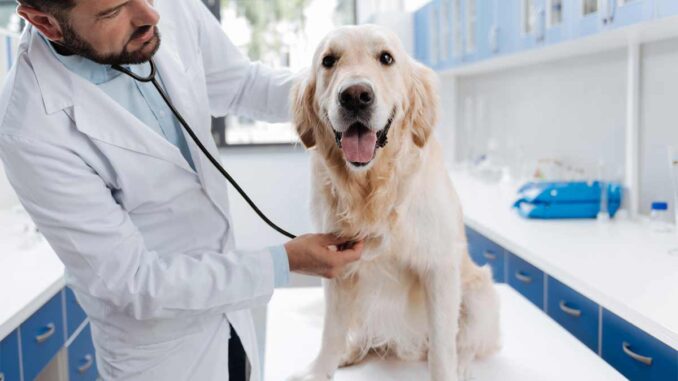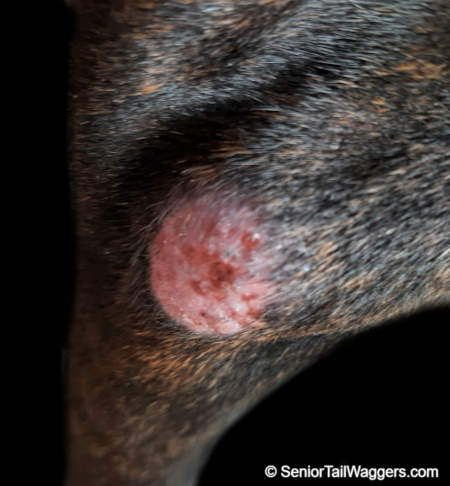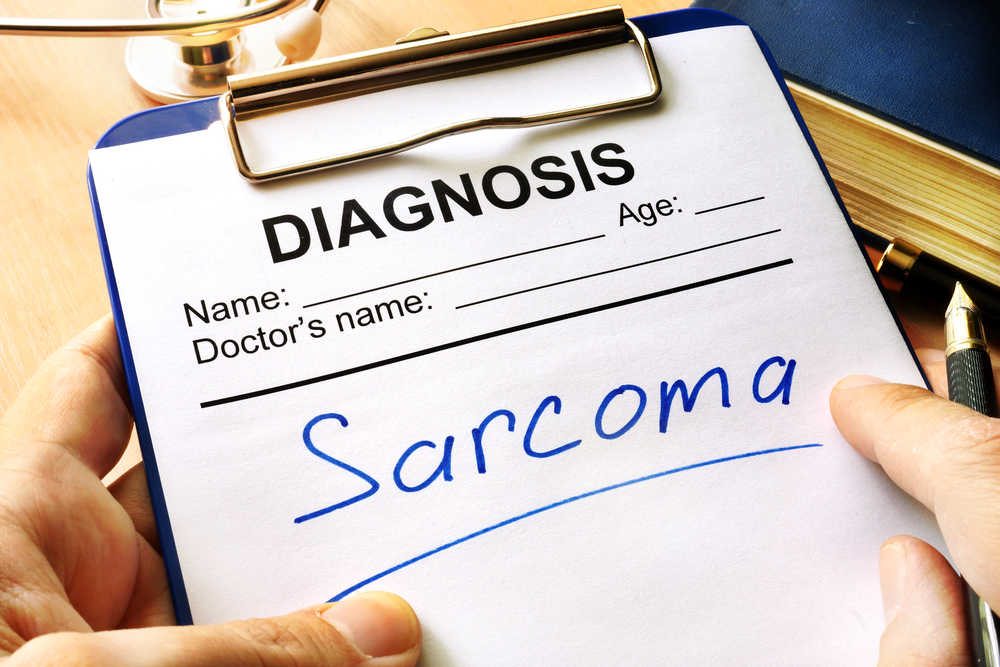
This article was updated on September 17th, 2023
Unfortunately I see dogs affected by Hemangiosarcoma far more frequently than I would like to in my practice. What can start as very vague signs of lethargy and tiredness can quickly progress into more sinister symptoms and I will often see dogs deteriorate very quickly in this situation.
The Story of Bruce, a German Shepherd with Hemangiosarcoma
Bruce was one such dog that I saw in my clinic recently. He was a 10-year-old German Shepherd dog who had been gradually deteriorating over the prior 2 weeks – becoming more lethargic, off his food and was vomiting at least once a day.

Initially his owners had put it down to old age but it quickly became apparent that there was something more sinister going on when Bruce tried to bite his owner when having his tummy stroked. He was clearly in pain and so investigations started.
A blood test showed elevated liver enzymes and a mild anemia. This, in combination with the painful tummy, prompted us to perform an abdominal ultrasound scan. Unfortunately, Bruce’s spleen was very enlarged and irregular in shape and the worst was suspected – he had a cancerous growth in his spleen, known as a hemangiosarcoma. He was rushed straight into surgery to attempt to remove his spleen.
Thankfully there was no evidence of spread of the tumor to other organs within his abdomen and his spleen was successfully removed. There was a possibility of microscopic metastasis to other organs and so Bruce was very closely monitored following his operation. Because of the aggressive nature of the tumor there is a possibility that it could grow back in other areas of his body, but for now a few months down the line, he continues to enjoy retirement.
What is Hemangiosarcoma in Dogs?
Hemangiosarcoma is a malignant cancer of the cells that line the blood vessels of the body. Therefore, hemangiosarcoma can occur anywhere in the body where blood vessels are found. But the most common areas that a hemangiosarcoma will grow are the surface of the skin (dermal), underneath the skin (subcutaneous) and in the internal abdominal organs (visceral). Because of its tendency to spread easily within the body, the dermal and subcutaneous forms of hemangiosarcoma will often progress into the more life-threatening visceral form. The most common organ affected is the spleen as it is essentially a big ball of blood vessels.
In the case of hemangiosarcoma, the cells that line the blood vessels start dividing uncontrollably and in an unhealthy manner. This leads to the development of a mass that is very prone to rupture and can even cause a dog to bleed out internally. The cells also have quick access to the bloodstream allowing them to very easily be transported elsewhere in the body resulting in metastasis of the cancer.
Unfortunately, because hemangiosarcoma can develop anywhere in the body, it often results in very non-specific symptoms in your dog and can go undetected for long periods of time. Because of this, dogs with hemangiosarcoma have poor survival rates as the tumor has progressed rapidly before being detected.
While hemangiosarcoma may have a genetic predisposition, any old dog is at risk due to carcinogens they may have been exposed to over their lifetime.
Common Symptoms Seen in Dogs with Hemangiosarcoma
The symptoms a dog suffering from hemangiosarcoma might display will depend on the location of the tumor. For the dermal and subcutaneous forms, skin lumps or changes might be detected. An example lump is shown on the image below (raised lesion with thickened skin, scabbing and fur loss due to a cutaneous hemangiosarcoma):

For the visceral form of hemangiosarcoma, the symptoms will partly depend on the organ(s) affected but common symptoms seen include:
- Lethargy and weakness
- Pale gums
- Enlarged or hard abdomen
- Rapid or labored breathing
- Reduced appetite
- Weight loss
- Vomiting
Signs Your Dog is Dying from Hemangiosarcoma (Final Stages)

In the end stages of hemangiosarcoma, the symptoms your dog displays might become very dramatic as the tumor starts to cause internal abdominal organs to shut down.
Ruptured tumors can lead to blood loss internally, resulting in anemia and a lack of oxygen delivery to the body tissues. This leads to weakness and lethargy as the normal metabolism that produces energy is compromised. A loss of blood can also lead to heart arrhythmias which in turn interfere with the proper delivery of blood around the body
Internal masses will often push on other vital organs within the abdomen, resulting in pain, discomfort and a reluctance to move. Damage to the liver or stomach can cause nausea and so vomiting is often seen.
If you would like to learn more about the late stages of hemangiosarcoma and the euthanasia decision, read my other article “When to Euthanize a Dog with Hemangiosarcoma“.
Is My Dog Suffering or in Pain due to Hemangiosarcoma?
This is a question that really only the owner can answer. Does your dog still have a quality of life? Do they still get excited at the things they used to enjoy?
A dog that is in pain, not eating or not able to move is not a happy dog and hemangiosarcoma is not a condition that should be left untreated. If treatment is not an option then unfortunately euthanasia may be the only option as it is not fair on your dog to leave them to die of ‘natural causes’.
Steps You Can Take at Home to Help a Dog with Hemangiosarcoma
The most vital part of helping a dog with hemangiosarcoma is to recognise the symptoms as early as possible. Unfortunately this is an aggressive form of cancer and dogs affected can deteriorate very quickly, so the sooner the cancer is removed and treated, the better the prognosis for your dog.
Be acutely aware of any changes or symptoms that your dog is displaying. Of course, some changes will occur naturally with old age but if the changes are progressing quickly then there could be something more sinister at play.
Is your old dog more lethargic than usual? Are they reluctant to go out for a walk or play? Do they seem to have labored or rapid breathing when resting? If any of these are true then you should take them to the vet immediately.
Vet Diagnosis

Your vet will start with a thorough clinical exam of your dog – checking their mucous membrane (gums) color, heart rate and rhythm, breathing rate, temperature and having a good feel of your dog’s abdomen for signs of pain.
The next step will be to perform blood tests to check organ function, blood protein levels and blood cells. Low numbers of red blood cells indicate anemia which could be caused by internal hemorrhage if an abdominal mass has ruptured.
Similarly blood protein levels may be reduced for the same reasons. Liver enzymes may be raised if hemangiosarcoma is affecting the liver, kidney values may be raised if the kidneys are affected. Analyzing your dog’s urine can also be helpful in the diagnostic process – blood or protein may be seen in the urine, especially in the case of renal hemangiosarcoma.
One of the most key diagnostic tools in identifying the presence of visceral hemangiosarcoma is performing imaging. This includes an ultrasound scan and X-rays. An ultrasound scan of the abdomen is performed to look for any abnormalities or growths developing on the abdominal organs as well as the presence of fluid (which coils indicate blood) within the abdomen. An X-ray gives an overall picture of the shape and size of the abdominal organs and therefore allows any tumors to be identified.
Dermal or subcutaneous hemangiosarcoma can be diagnosed by sampling any skin lumps present.
Veterinarian Treatment & Life Expectancy
In the case of dermal and subcutaneous hemangiosarcoma, treatment involves surgical excision of the tumor. This is often combined with chemotherapy in order to try and kill any cancerous cells that may have spread elsewhere in the body. A combination of these two treatment methods is generally effective.
Treatment of the visceral form of hemangiosarcoma is where challenges can arise because this form of the cancer can go undetected until the disease is advanced. Surgical removal of the tumor is the preferred treatment choice but this will depend on its location and if it has undergone metastasis (spread elsewhere in the body). Splenic hemangiosarcoma is treated by removing the whole spleen – this is an organ that a dog can live without. Hemangiosarcoma of other abdominal organs carries a poorer prognosis however as there isn’t the option to remove the organ in its entirety. Chemotherapy is often used as an adjunctive therapy to surgery, especially if the tumor couldn’t be completely removed. Chemotherapy is not curative but it aims to slow the growth of cancerous cells present, thus increasing survival times.
Radiotherapy is used as a palliative treatment option, often used in the case of dermal hemangiosarcoma where complete surgical removal was not possible.
Prognosis and Life Expectancy Estimates
The life expectancy for dogs with hemangiosarcoma will depend on the type and location of the tumor.
- Dermal hemangiosarcoma was shown to have a median survival time of 780 days following successful surgical removal of cancerous tissues.
- Subcutaneous hemangiosarcoma has a higher tendency for metastasis, spreading to the internal organs in two thirds of cases. The median survival time following surgical removal is 172-307 days.
- Visceral hemangiosarcoma comes with the worst prognosis due to its very aggressive nature. The mean survival time in these cases is 3-6 months, depending on how quickly a diagnosis is made.
FAQ with the Vet
Are certain breeds more likely to be affected?
Any dog is prone to developing hemangiosarcoma. However, it occurs more often in breeds such as Golden Retrievers, German Shepherd Dogs, Flat Coat Retrievers, Boxers and Bernese mountain dogs. For example, according to “Breed predispositions to disease in dogs and cats” by Alex Gough, the German Shepherd is at high risk of hemangiosarcoma with an odds ratio of 4.7 for developing hemangiosarcoma, compared to other purebred dogs.
Are there any at-home treatments or over the counter medication that can help your dog feel better?
At home treatments are limited for hemangiosarcoma. As hemangiosarcoma is an aggressive cancer it requires very aggressive treatment. Anti-inflammatory medication such as corticosteroids can be used to reduce the inflammation associated with any tumors. Anti-sickness medication may also be necessary, especially for dogs on chemotherapy.
Do we know what causes hemangiosarcoma?
The exact causes of hemangiosarcoma are poorly understood, but as with other cancers, exposure to carcinogens over long periods of time plays a role. Every time a cell of the body divides, there is the potential for a genetic mutation to occur. This mutation can lead to cancer. Carcinogens can increase the likelihood of these mutations occurring.
Old age in general will predispose to the development of hemangiosarcoma as the cells will have divided many times before and the division process becomes less efficient. Ultimately, not much can be done to prevent hemangiosarcoma unfortunately so the focus should be on early detection and treatment.
Disclaimer: This website's content is not a substitute for veterinary care. Always consult with your veterinarian for healthcare decisions. Read More.


Be the first to comment